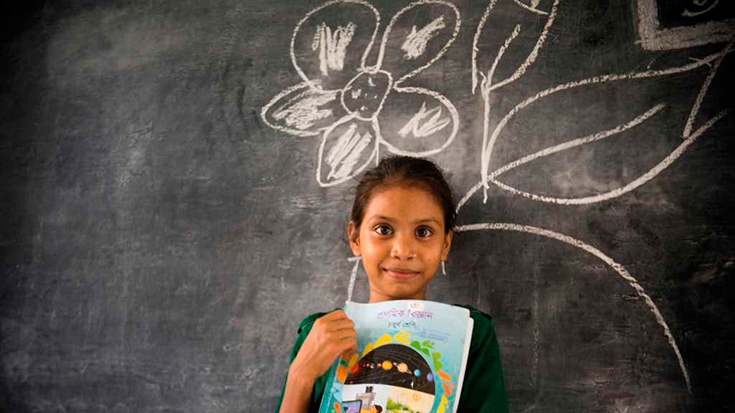Bangladesh is at a crossroads, given its education development and economic growth pattern, towards its goal of becoming a middle income country.
The country has been successful in improving access to education and completion at all levels, despite daunting challenges. Bangladesh achieved gender equity in primary and secondary education well ahead of the 2015 Millennium Development Goal. As of 2010, about 76% of youth aged 15-19 completed primary education. Progress in education has paved the way for an increasing number of women to enter the labor market, bolstering the country’s productions in the manufacturing industry.
However, after spectacular success in expanding access to education, Bangladesh now needs to focus on high-quality learning, and strong foundational cognitive and behavioral skills from early childhood, finds the report: “Seeding Fertile Ground: Education That Works for Bangladesh”.
The report, which focuses on access and equity, quality and skills, was prepared under continued guidance of two advisory groups drawn from the members of civil society, the government, academia, think-tanks and development partners in Bangladesh. The World Bank partnered with the leading education NGO network in Bangladesh ‘Campaign for Popular Education’ (CAMPE) to share the findings with school communities, teachers, teachers’ unions, civil society groups, political leaders, and policy makers in the entire country that drew considerable attention from the national media.
Access and Equity
Though Bangladesh has improved access to education and achieved gender equity in both primary and secondary education, 5 million students are still out of school. Inequalities still exist due to demand and supply constraints. Poor and disadvantaged students in urban slum areas and rural remote areas lag behind. Female enrollment is still low in higher and vocational education. Although repetition and drop-out rates have declined, they are still high and transition rates are low across the various levels of education. Besides, low levels of learning is a major problem that the country is trying to grapple with.
Education Quality
Learning in Bangladesh is currently low and unequal. Only a limited number of students remain competent in their respective grades. An assessment of literacy and numeracy at grade 5 indicates that only 25 percent of grade 5 students master Bangla competencies, and only 33 percent master Mathematics. Regional differences exist and children from poor families are at least three-fourths of a school year behind their richer counterparts in Bangladesh, and half a school year behind in Mathematics. Students with low levels of learning at lower grades are most at risk for dropping out and are most likely to join the informal labor market.
An important determinant of learning within the school is the quality of the teachers. Studies show that many teachers lack adequate training and career progression opportunities. Lack of knowledge about subjects and emphasis on rote-learning (encouraged by an examination system that tests memory recall at many stages in the schooling cycle) instead of encouraging creative thinking and problem-solving skills further affect students’ learning.
Skills Development
Bangladesh’s current momentum in improving education can be harnessed for greater advances, states the report. Understanding the complexity and interrelated nature of education quality, skills development, and the labor market will aid in policy planning. The country needs to shift and strengthen the focus on education relevant to the labor market and on the quality of education.
Improving skills and productivity are crucial for Bangladesh to achieve middle income status. Currently, most of the labor force is in informal sector with low levels of education – 67 percent of the labor market has less than a primary education, 96 percent of workers have up to a secondary education, and less than 5 percent of the workforce has a tertiary education.
The Way Forward
Some concrete actions that might be taken to improve access, quality and relevance of education are to:
· Target the remaining hardest-to-reach population groups to attain universal access in primary education and equalize educational opportunities through quality early child development, developing programs to address the educational needs of children in urban slums, scaling up stipend programs and working in partnership with the non-government sector.
· Provide adequate funding for education by increasing allocations of the national budget for secondary education and support resource mobilization in higher education.
· Prioritize high quality learning in lower grades and build strong foundation cognitive and non-cognitive skills through examination reforms and by setting national learning goals that make sure that the system values strong literacy, numeracy competencies and interpersonal and behavioral skills, such as problem solving.
· Raise the minimum standard of performance at all schools in the country by setting competencies that students should acquire in different subjects, the expected competencies from educators, and accreditation standards to enable quality assurance of various programs.
· Engage in sector wide planning to explore synergies in the most pressing areas of collaboration including teacher development, national assessment, national examination and creating a curriculum framework for academic and vocational secondary education to provide a basic set of secondary competencies in all graduates.
· Articulate a simple comprehensive long-term vision of skills development considering skills development as an incremental and lifelong process, acquired through formal and non-formal education, from pre-primary through higher education, networks, jobs, and other means.
· Reskill the current low-skilled workforce in both formal and informal employment with emphasis on strong cognitive skills, along with positive behavioral skills that can lead to better jobs and career advancement.
· Improve the investment climate and jobs creation potential so that increased investments lead to the creation of more high-skilled jobs.

